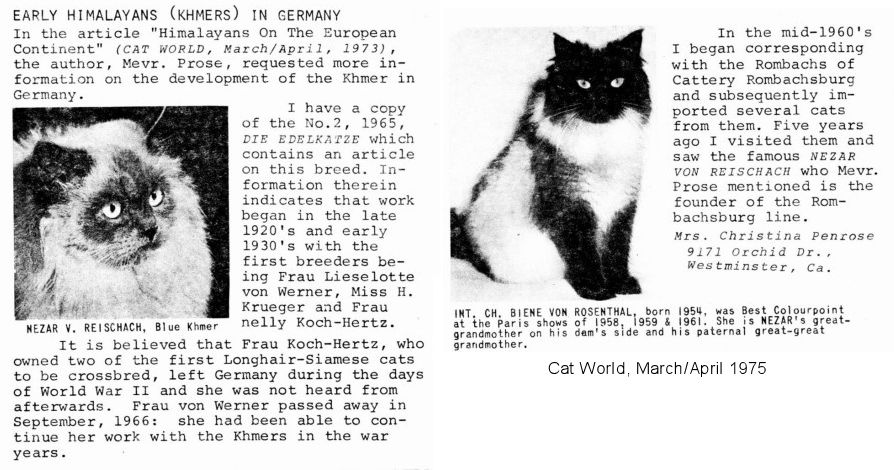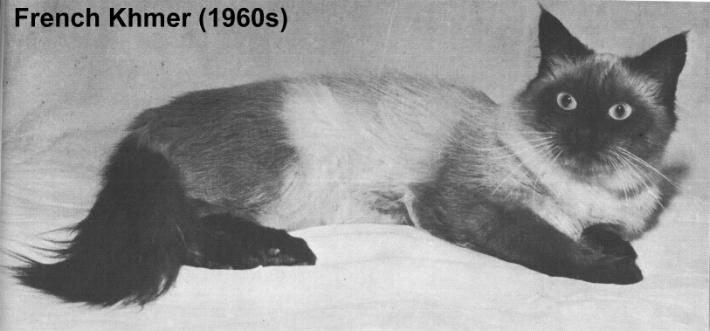

THE KHMER (FRENCH COLOURPOINT LONGHAIR)
The Khmer Cat is described in "Son Altesse le Chat" 1935, Jean Rieger, and in 1966 by Fernand Mery. Mery noted the similarity of emerging colourpoint Persians (Himalayans) to the existing French Khmer, although the photographs of the Khmer suggested a semi-longhaired cat. Mery noted that it had a breed standard albeit one not recognised by FIFe, however the term Khmer had been dropped back in 1955 when Colourpoint Longhairs and Himalayans were being simultaneously developed in America/Canada and Britain.
"La Vie a Campagne" in the late 1920s showed a semi-longhaired Khmer. Its origin has been conflated with that of the Birman: a pair of Khmer cats were supposedly taken to Paris from Indochina by a French serviceman - a tale very similar to that of the Birman (two Birman were reputedly obtained by Major Gordon Russell from Burmese priests whom he had helped escape to Tibet; when he went to live in France in 1919 he took his Birman cats with him). This suggests that the French Khmer was a poor-man’s Birman; one that lacked the characteristic white gloves and boots of the Birman.
According to Rieger in 1935, the Khmer got its name because of its Indo Chinese origin and from being distinct from the Birman despite its obvious resemblance. At that time it was rare and the only known specimens were in France. He wrote that in 1928/29 an ex-serviceman returning from Indo China had brought some csts back with him, but abandoned them at a farmer near Paris, where they bred unrestricted although many did not survive. In 1934, Rieger acquired the finest of the specimens sired by the original male, but the original female had died, leaving a daughter to maintain and perpetuate the breed. The fate of the parents is the inverse of the Birman story!
|
|
|
THE KHMER CAT, A RECENTLY OBTAINED BREED – Jean Rieger, Vie A La Campagne, 1935
ORIGINATING FROM THE FAR ORIENT, THIS INTELLIGENT ANIMAL IS A RIVAL TO THE PERSIAN THROUGH ITS HARMONIOUS SHAPE AND MAGNIFICENT FUR
Named thus because of its Indochinese origin, the Khmer presents itself as a variety or type very different from the Birman, despite some points of resemblance. There are few representatives of this recently constituted breed. The only known specimens are currently in France.
ORIGINS
Five or six years ago an old soldier, returned from Indochina, abandoned a couple of young cats of unknown breed with a farmer in the Paris region. These cats grew and reproduced in complete freedom. There were numerous births. Due to poor care, the majority of the little ones perished. Ln 1934, I was able to acquire the most beautiful of the specimens, from the original male; the female was dead, leaving a daughter who could maintain and perpetuate the line. Today several young females give rise to the hope that the future of the breed is assured.
ESSENTIAL CHARACTERISTICS
General Appearance: The Khmer cat gives an appearance of harmonious strength, balance and great vigour, this being emphasized by its bright expression. It has good size, good limbs, it is robust and endowed with strong boning.
Head: Strong and round. Nose: fairly wide and short. Muzzle: small but powerful. Lips: connected. Whiskers: white ticked with brown; very well developed and prominent. The whiskers reach 14 cm long. Jaws: furnished with very strong teeth, with canines slightly protruding. Skull: large. Eyes: set slightly oblique, round, vivid blue, limpid and expressive; shine red in the darkness. Ears: rather long, furnished with down. Neck: short.
Body: long. Withers: normal. Chest: rounded. Flanks: normal. Back: almost a straight line. Haunches and rump: solid.
Toes: strong and muscular, front paws lightly arched. Feet: long, furnished with brown hair, strong, sharp claws.
Tail: always long and furnished with long hair, straight and flexible, without break of nodules, carried low with the tip slightly raised.
Coat: the hair is long and fine, forming a superb ruff around the neck; wavy under the belly. The colour is that of the Birman: dark cream, turning to almost otter-brown on the head, shoulders and legs/paws, the tail has magnificent intermediate tones. In daylight, the Khmer cat appears golden.
The kittens are born pure white, getting markings later. From the third or fourth day a dark grey under coat appears which then disappears at around four or five months. This dark undercoat of the young is a characteristic of the breed. At around six months the body is nearly white, the markings very distinct, the mask is splendid, then with age, this definition becomes less pronounced as a result of the dark fur colour (it takes 18 months for the animal to become adult).
Unlike the Birman, which must have four white gloved paws (this obtained by selection), the Khmer must present with paws which are entirely golden otter brown. Today some specimens have white digits, very likely due to consanguinity and to gloved ancestors. However this feature is reserved for the Birman and should be avoided in the future, which is possible if careful selection is undertaken.
Weight: a good male weighs about 4.5 kg to 6 kg; a female weighs 3.5 kg to 4.5 kg.
Defects: Head too long. Eyes pale or cloudy. Feet too small.
Disqualification: Boning too light, small size or too light weight; fur too short.
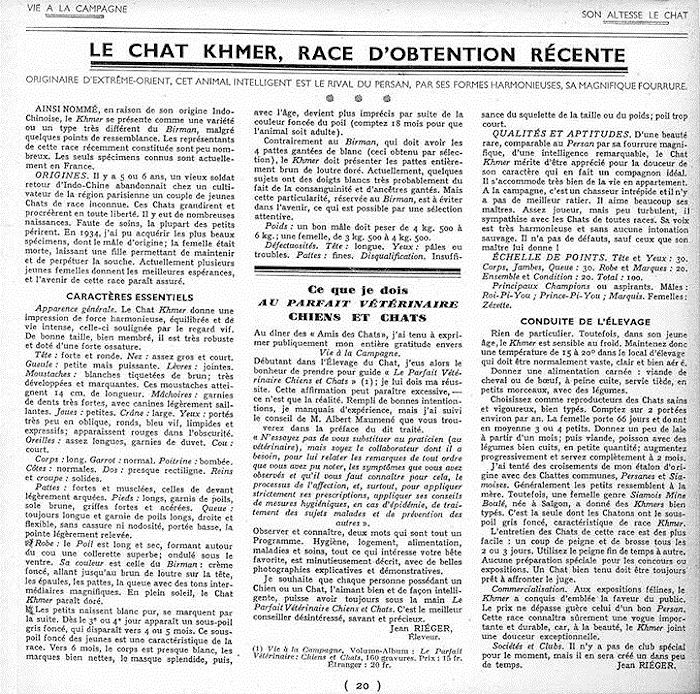
QUALITIES AND APTITUDES
This is a rare beauty, comparable to the Persian because of its magnificent fur, with its remarkable intelligence the Khmer cat is worthy of being appreciated for its gentle character which makes it an ideal companion. It is well-suited to living in an apartment. In the countryside it is an intrepid hunter and there is no better ratter. Quite playful, but not unruly, it gets on well with all breeds of cat. It voice is very harmonious and lacks any harsh tones. It has no faults except those which its master gives it!
SCALE OF POINTS
Head and Eyes – 30
Body, Legs and Tail – 30
Coat and Markings – 20
Overall Appearance and Condition – 20
Total – 100
BREEDING MANAGEMENT
Nothing special. However, when young the Khmer is sensitive to cold. Keep the temperature at 15 to 20 degrees (Centigrade) in the breeding areas, which must normally be large, bright and well ventilated. Give a meat-based diet: horse-meat or beef, lightly cooked, served lukewarm, cut into pieces, with some vegetables.
For breeding cats choose vigorous, healthy cats with good type. Expect 2 litters per year. The female carries for about 66 days and produces, on average, 3 to 4 kittens. Give a little milk at around one month; then meat and fish with well cooked vegetables in small quantities. Increase this gradually and serve this alone at 2 months.
I tried to cross my original stud cat with common female cats, Persians and Siamese females. Generally the offspring resembled the mother. However, a Siamese female Mine Boule, born in Saigon, produced Khmers of good type. There was one among the kittens which had the dark grey undercoat characteristic of the Khmer breed.
The maintenance of cats of this breed is very simple: brush and comb them every 2 or 3 days. Use a fine-tooth comb from time to time. No special preparation is needed for contest or exhibition. A well-kept cat is always ready to face the judge.
MARKETING
At cat shows, the Khmer won the favour of the public right from the start. The price does not exceed that of a good Persian. The Khmer breed will probably enjoy an and important and enduring fashion, because of its beauty combined with exceptional gentleness.
CAT SOCIETIES
There is no speciality club at present, but one will be created in a short while.
PRINCIPAL OR UPCOMING CHAMPIONS: Males: Roi-Pi-You; Prince-Pi-You, Marquis; Females; Zezette.

Khmer kittens (averaging 3-4 in a litter) were said to be sensitive to the cold and they needed a meat diet, not a milk diet. At that time, milk diets were commonly given to growing kittens, which probably led to high mortality rates (along with inbreeding issues). At the time he wrote his account, Rieger expected a Khmer club to be formed. In the fullness of time, the Khmer vanished and the Birman and Himalayan both thrived. Today, the Khmer is regarded as either a proto-Himalayan or a bootee-less Birman.
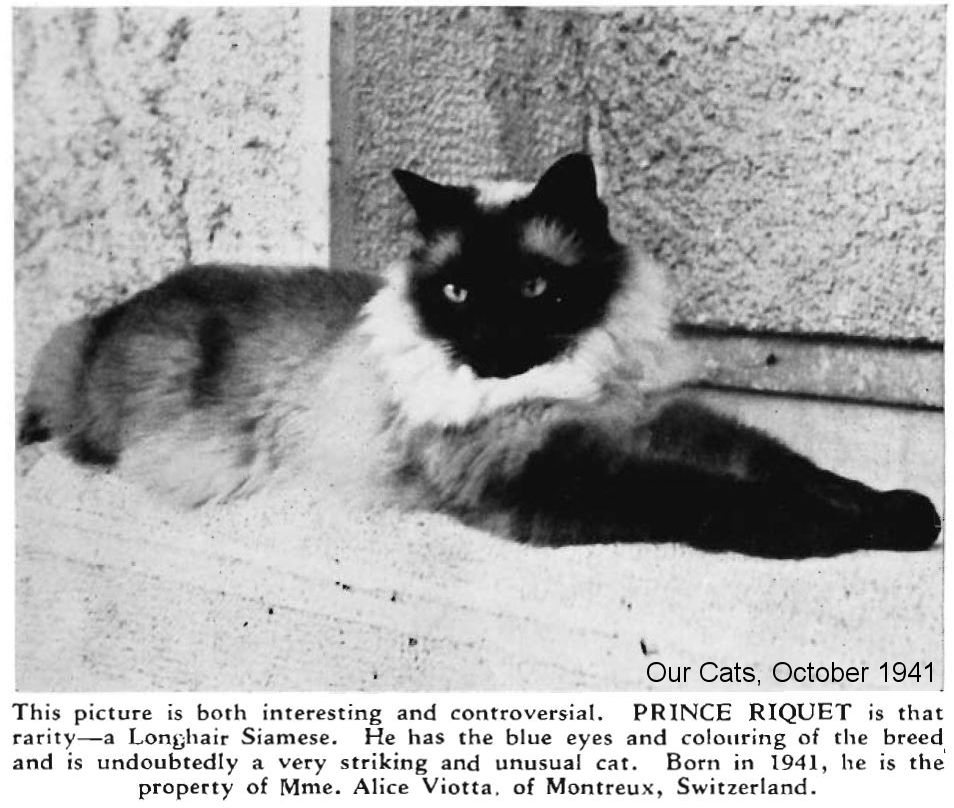
That Siamese Longhair, Our Cats, 1941. The photograph of Prince Riquet, the Siamese Longhair, which appeared in our October issue, aroused considerable interest and elicited enquiries as to his breeding. His owner, Mme. Alice Viotta, a Dutch lady living in Montreux, Switzerland, has very kindly given us the following information: "I cannot tell your readers much about the origin of Prince Riquet as he was given me as a present. I only know that his mother was a Siamese and that his father looked exactly like Riquet himself. Father and son look just like the sacred cats of Birmany (Burmah), but they have no white spots on their feet. However, it is my belief they are descendants of the two cats stolen from the temple of Lao-Tsun about the year 1932 (?). Riquet has all the characteristics described in the book by Marcel Reney about the sacred cats of Birmany. I have had many cats but can assure you that Riquet is an extraordinary animal—a fairy tale cat! His eyes are deep and clear like mountain lakes; he loves music and especially the music of Chopin. As I am a pianist he hears plenty of music and I am sure he can distinguish good music from bad. For a drink he prefers water served in a jade jug with a fresh flower in it. In the garden he follows me always like a dog. He still misses his little dog friend who died last year."
Our Cats October 1949: A Longhair Siamese, Prince Riquet, was brought by his owner, Mme. Alice Viotta, for me to judge, but I regretted I could not do so, as in England we have no standard for this variety. He was in lovely condition and obviously a great pet. – Joan Thompson
Report from the "Salon du Chat" show in Our Cats, January 1952: It was a great pleasure (writes Miss D. M. Collins) to accept the invitation of the President, Mme. Andree Peyraud, to judge again at the Club des Amis des Chats Show in Paris. It was a three-day event in early November. . . . Among the unusual cats were Mme. Röcher's Bambi and Bobeche, a pair of Moroccans, which are similar to our Grey Tabby Shorthairs, and Mme. Petit’s Longhair Siamese, Kmers. It was interesting to compare Kmers with Mr. Stirling-Webb’s Briarry Abu Het, whose photo l had with me and which Mme. Petit admired very much.
Report from "Le Cercle Felin de Paris" Cat Show in Our Cats, July 1952: English judges were Miss D. M. Collins (Longhairs) and Mrs. E. Towe (Shorthairs). Siamese entries fell far below English Standards but the Longhair Siamese Mousse de Vincelles was an interesting exhibit with the true colouring of the variety, a dark ruffle and bushy tail.
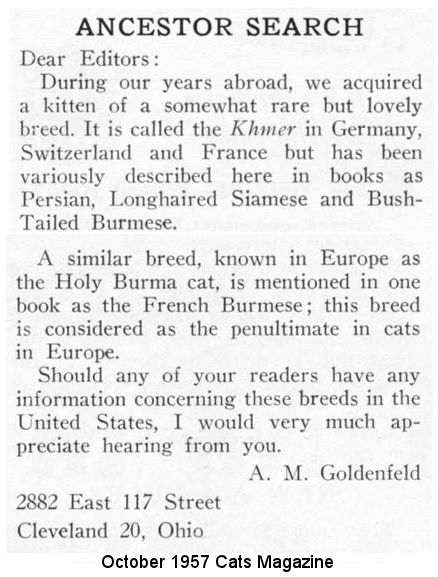
In Cat World Internation, March-April 1973, the article "Himalayans on the European Continent" by French-born Mevr. Prose-Imbert provided a little more about the Khmers. According the article, while all Himalayan breeders know about the development of the colourpoint longhair in England in 1950 by Brian Stirling-Webb, and the almost simultaneous development in the USA by Marguerita Goforth in California, there is an overlooked chapter in the breed's development. It was overlooked because it was published in journals in Europe and was not written in English.
The first-known colourpoint cats of Persian type existed in Germany prior to World War II and were first called Persiams and then Khmers. Their story was only published in a German magazine. A breeder in Berlin experimented with a number of outcrosses and did extensive work with Persiams/Khmers. The name Khmers was retained until the breed was recognized as the Colourpoint in England in 1955; this name was adopted by the European breeders and the different lines were unified.
A leading cattery working with the Colourpoints at that time was Frau Schafer's "Vogelsberg" Cattery which began breeding with cats from the Rosenthal Cattery. Frau Schafer specialized in Seal Points and Vogelsberg was already known by the mid 1950s. There was a Red Point Khmer at the Wiesbaden show in 1964, Bubi von Sameck, from East Germany. At the same show there was a 7 month old kitten, Nezar von Reischach (born April 1963), owned by Frau Rombach of "Rombachsburg" Cattery and this cat went on to become the founder of her Frau Rombach's colourpoint longhair (Himalayan) line.
Swiss Himalayans, though mostly the result of English and Dutch imports, included German Khmers in the early years. It's not known if the Khmers were crossed to the English and Dutch cats.
